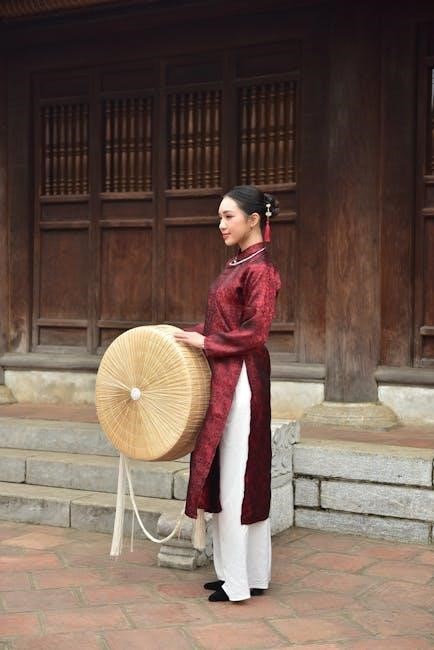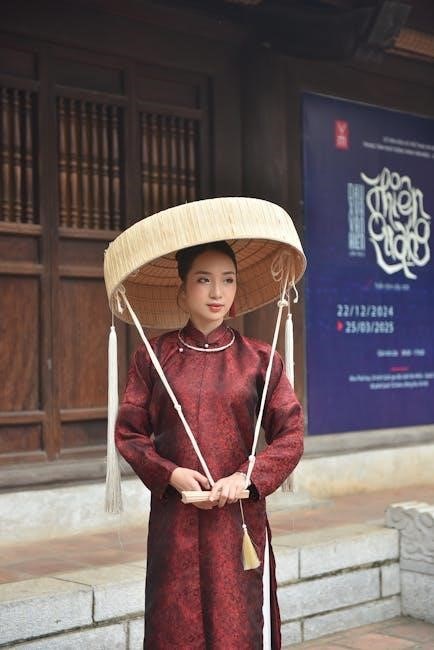ceremony leslie marmon silko pdf
Ceremony, a groundbreaking novel by Leslie Marmon Silko, explores themes of identity, cultural dislocation, and healing through the story of Tayo, a Laguna Pueblo veteran․ Published in 1977, the book blends traditional storytelling with modern narrative techniques, offering a profound exploration of resilience and cultural preservation․ The novel is widely studied and its PDF version is easily accessible for academic and personal reading․
1․1 Overview of the Novel
Ceremony, written by Leslie Marmon Silko, is a poignant narrative about Tayo, a Laguna Pueblo veteran struggling with PTSD after World War II․ The novel intertwines traditional Laguna stories with Tayo’s journey toward healing and cultural identity․ Set in the post-war era, it explores themes of resilience, spirituality, and the clash between indigenous traditions and modern society․ The PDF version of this seminal work is widely available for readers․
1․2 Historical Context and Significance
Ceremony, set post-World War II, reflects the turmoil faced by Native American veterans like Tayo, grappling with cultural dislocation and trauma․ Silko’s work highlights the historical struggles of indigenous communities, offering a counter-narrative to Eurocentric perspectives․ The novel’s emphasis on traditional healing ceremonies underscores the enduring strength of Native American culture․ Its PDF availability ensures this vital history reaches modern readers, preserving its legacy․
The Protagonist: Tayo’s Journey
Tayo, a Laguna Pueblo veteran, returns from World War II, battling cultural dislocation and personal trauma․ His journey intertwines healing, identity, and the blending of traditional and modern worlds․
2․1 Tayo’s Background and Identity
Tayo, a Laguna Pueblo veteran, grapples with his mixed heritage and the trauma of World War II․ His identity is shaped by cultural dislocation and the horrors of captivity, reflecting the broader struggles of Native Americans․ The PDF version of Ceremony provides deeper insights into his journey of self-discovery and healing․
2․2 The Impact of World War II on Tayo
World War II deeply scars Tayo, a Laguna Pueblo veteran, as he endures captivity and the horrors of war․ The trauma erodes his will to survive, leaving him emotionally shattered․ The PDF version of Ceremony highlights his struggle to reconcile his experiences with his cultural identity, underscoring the profound impact of the war on his psyche and spiritual well-being․

Themes in “Ceremony”
Ceremony by Leslie Marmon Silko delves into themes of identity, cultural dislocation, and healing․ The PDF version emphasizes resilience, blending traditional Laguna Pueblo beliefs with personal and collective survival․
3․1 The Struggle with Identity
In Ceremony, Tayo’s identity is a central theme, reflecting his mixed heritage and post-war trauma․ The PDF highlights Silko’s exploration of cultural fragmentation and the tension between traditional Laguna Pueblo beliefs and modernity․ Tayo’s journey symbolizes the broader struggle of Native Americans to reconcile their identities amid colonialism and assimilation, resonating deeply in the digital edition’s analysis․
3․2 Healing and Spiritual Restoration
In Ceremony, healing is a central theme, as Tayo seeks spiritual restoration after the trauma of World War II․ The novel emphasizes the importance of traditional Laguna rituals and storytelling in mending emotional and cultural wounds․ Through Betonie’s guidance, Tayo learns to reconcile his past and present, blending ancient ceremonies with modern realities․ The PDF edition highlights how these rituals foster resilience and renewal․
The Role of Ceremony in the Novel
Ceremony is central to the novel, serving as a means of healing, cultural preservation, and spiritual connection․ The PDF edition highlights its significance in Tayo’s journey and community renewal․
4․1 Traditional Ceremonies and Their Meaning
Traditional ceremonies in Ceremony are deeply rooted in Laguna Pueblo culture, offering spiritual guidance and communal healing․ These rituals, detailed in the PDF version, connect Tayo to his ancestors, emphasizing harmony with nature and the restoration of balance․ Silko portrays ceremonies as vital to identity and resilience, countering the disruptive forces of colonialism and war through ancient, enduring practices․
4․2 Ceremony as a Form of Resistance
Ceremonies in Silko’s novel serve as acts of cultural resistance, challenging Eurocentric narratives and the erasure of indigenous traditions․ By preserving ancient rituals, Tayo and his community assert their identity and resilience․ The PDF highlights how these ceremonies counter colonialism’s destructive influence, restoring spiritual strength and unity among the Laguna Pueblo people, thereby fostering survival and cultural continuity in the face of oppression․
Narrative Structure and Style
Silko employs a non-linear narrative, blending myth and reality to reflect the fragmented nature of Tayo’s experience․ The PDF version highlights her unique storytelling style, combining traditional oral narratives with modern literary techniques, creating a rich, layered exploration of identity and healing․
5․1 Non-Linear Storytelling
Ceremony features a non-linear narrative, weaving past and present through Tayo’s memories and myths․ This structure mirrors his fragmented psyche, reflecting the disjointedness of his war experiences and cultural dislocation․ The PDF version preserves Silko’s unique storytelling, allowing readers to experience the fluid transition between reality and myth, emphasizing the novel’s themes of healing and identity․ The digital format enhances accessibility, maintaining the original’s emotional depth and complexity․
5․2 Blending of Myth and Reality
Ceremony seamlessly integrates myth and reality, creating a rich narrative that explores Tayo’s journey․ Silko interweaves traditional Laguna stories with Tayo’s WWII experiences, reflecting his internal struggle and cultural identity․ The PDF version highlights this blend, offering readers a deeper understanding of how myth serves as both a source of comfort and a means to confront trauma, ultimately aiding Tayo’s spiritual restoration and healing․
Cultural and Historical Significance
Ceremony holds profound cultural and historical significance, offering insights into the Laguna Pueblo traditions and the impact of WWII on Native American communities․ The PDF version preserves this vital narrative, blending personal and collective experiences to highlight resilience and cultural survival․
6․1 The Laguna Pueblo and Their Traditions
The Laguna Pueblo, a Native American community in New Mexico, is central to Ceremony․ Their rich traditions, including storytelling and rituals, are vital to their identity․ The novel highlights how these customs provide healing and continuity, especially for Tayo․ Available in PDF, Silko’s work offers a deep dive into Laguna culture, emphasizing its enduring significance․
6․2 The Impact of Colonialism and War
The novel examines the devastating effects of colonialism and war on Native American communities․ Tayo’s experiences in WWII and the cultural disruption caused by colonialism are central themes․ The PDF version of Ceremony highlights how these traumas impact identity and tradition, offering a poignant reflection on resilience and survival․ Silko’s work provides a critical lens on historical injustices and their lasting legacy․

The Role of Land and Landscape
The land in Ceremony symbolizes spiritual connection and heritage․ Its destruction reflects broader environmental and cultural losses, as detailed in the PDF version of Silko’s work․
7․1 The Spiritual Connection to the Land
In Ceremony, the land is deeply intertwined with the spiritual identity of Tayo and his community․ The PDF version highlights how the Laguna Pueblo people view the land as a sacred entity, essential for their ceremonies and storytelling․ This connection is vital for healing and maintaining cultural traditions, emphasizing the land’s role as a living, spiritual being rather than a mere physical space․
7․2 The Destruction of the Environment
The PDF version of Ceremony underscores the devastating impact of environmental destruction on indigenous communities․ The exploitation of land and natural resources disrupts sacred ceremonies and traditions, reflecting the broader consequences of colonialism and modernization․ Silko highlights how this destruction alienates Native Americans from their spiritual connection to the earth, exacerbating cultural and personal crises like Tayo’s․

The PDF Version of “Ceremony”
The PDF version of Ceremony by Leslie Marmon Silko is widely available for download, offering a convenient format for readers․ Published by Penguin, it ensures easy access to this seminal work of Native American literature, featuring a digital edition that preserves the original text’s depth and cultural significance․
8․1 Availability and Accessibility
The PDF version of Ceremony is widely available for download from various online platforms, ensuring easy access for readers worldwide․ Published by Penguin, it is offered in formats like ePub and MOBI, catering to different preferences․ The digital edition is DRM-free, allowing readers to access the novel across multiple devices․ This accessibility has made Ceremony a convenient choice for academic and personal reading, preserving its cultural and literary significance․
8․2 Features of the Digital Edition
The digital edition of Ceremony offers enhanced readability with features like adjustable font sizes and night mode․ The PDF version includes a detailed table of contents for easy navigation․ Published by Penguin Vitae, it features an introduction by Larry McMurtry, providing context to Silko’s work․ The DRM-free format ensures compatibility across devices, making it a versatile option for readers seeking a seamless experience of this seminal Native American novel․
Critical Reception and Analysis
Ceremony has received widespread acclaim for its profound exploration of cultural identity and healing․ Scholars praise Silko’s innovative storytelling, blending myth and reality, and its postcolonial insights․
9․1 Scholarly Perspectives on the Novel
Scholars widely praise Ceremony for its innovative narrative techniques and profound cultural insights․ Silko’s blending of myth, history, and personal narrative challenges Eurocentric perspectives, offering a powerful counter-narrative․ Her exploration of identity, trauma, and healing resonates deeply, making the novel a cornerstone of Native American literature․ The PDF version enhances accessibility, allowing global readers to engage with Silko’s seminal work․
9․2 Comparisons with Other Works
Leslie Marmon Silko’s Ceremony is often compared to works by Scott Momaday, Gerald Vizenor, and James Welch, sharing themes of cultural identity and colonial impact․ Like these authors, Silko blends traditional storytelling with modern techniques, enriching Native American literature․ The PDF version of Ceremony facilitates easy comparison with other works, enhancing scholarly analysis and reader accessibility to these seminal texts․
Leslie Marmon Silko’s Biography
Leslie Marmon Silko, born in 1948 to a family of Mexican, Laguna Indian, and European ancestry, is a celebrated Native American writer․ Her novel Ceremony (1977) is a landmark in Native American literature, and its PDF version remains widely accessed for scholarly and personal reading․
10․1 Early Life and Influences
Leslie Marmon Silko was born in 1948 to a family with Laguna Pueblo, Mexican, and European roots․ Her early life on a reservation in New Mexico deeply influenced her work, blending cultural traditions with personal experiences․ The stories of her grandmothers and the Laguna oral tradition shaped her narrative style, evident in Ceremony, which reflects her cultural heritage and spiritual connections․
10․2 Her Contributions to Native American Literature
Leslie Marmon Silko is a pivotal figure in Native American literature, celebrated for her unique voice and cultural authenticity․ Her novel Ceremony is a landmark work, blending traditional storytelling with contemporary themes, offering a powerful counter-narrative to colonialism․ Her writing has inspired many, preserving indigenous traditions while addressing modern struggles, making her a cornerstone of Native American literary legacy and a key figure in its revitalization․

The Title “Ceremony” and Its Implications
Ceremony signifies the healing rituals central to Tayo’s journey, reflecting the novel’s exploration of identity and cultural restoration․ The title encapsulates the blend of tradition and resilience․
11․1 The Significance of Rituals
Rituals in Ceremony hold profound significance as they embody the spiritual and cultural practices of the Laguna Pueblo․ These ceremonies, rooted in ancient traditions, serve as a means of healing and reconnecting Tayo with his heritage․ By participating in rituals, Tayo finds solace, rediscovers his identity, and restores balance within himself and his community, highlighting the enduring power of cultural traditions․
11․2 The Title’s Connection to the Plot
The title Ceremony reflects the novel’s central theme of healing through traditional rituals․ Tayo’s journey is marked by his participation in ceremonies that help him recover from war trauma and reconnect with his Laguna heritage․ These rituals symbolize the restoration of balance and identity, emphasizing the novel’s focus on cultural resilience and the transformative power of tradition in addressing modern struggles․
The Legacy of “Ceremony” in Modern Literature
Ceremony remains a seminal work in Native American literature, inspiring contemporary writers with its exploration of identity and cultural resilience․ Its themes of healing and tradition continue to resonate, making it a timeless classic accessible through its widely available PDF format․
12․1 Its Influence on Contemporary Writers
Ceremony has profoundly influenced contemporary writers by blending traditional Native American storytelling with modern narratives․ Authors like Louise Erdrich and Sherman Alexie draw inspiration from Silko’s exploration of identity and cultural resilience․ The novel’s themes of healing and resistance continue to resonate, making it a foundational text in Native American literature․ Its accessibility in PDF format ensures its reach and impact endure․
12․2 The Novel’s Relevance Today
Ceremony remains deeply relevant today, offering insights into identity, cultural resilience, and environmental degradation․ Its exploration of mental health, trauma, and healing resonates with contemporary discussions on wellness․ The novel’s themes of resistance and indigenous knowledge continue to inspire activism and literary innovation․ The availability of the PDF version ensures its accessibility, making it a vital read for modern audiences grappling with similar challenges․

